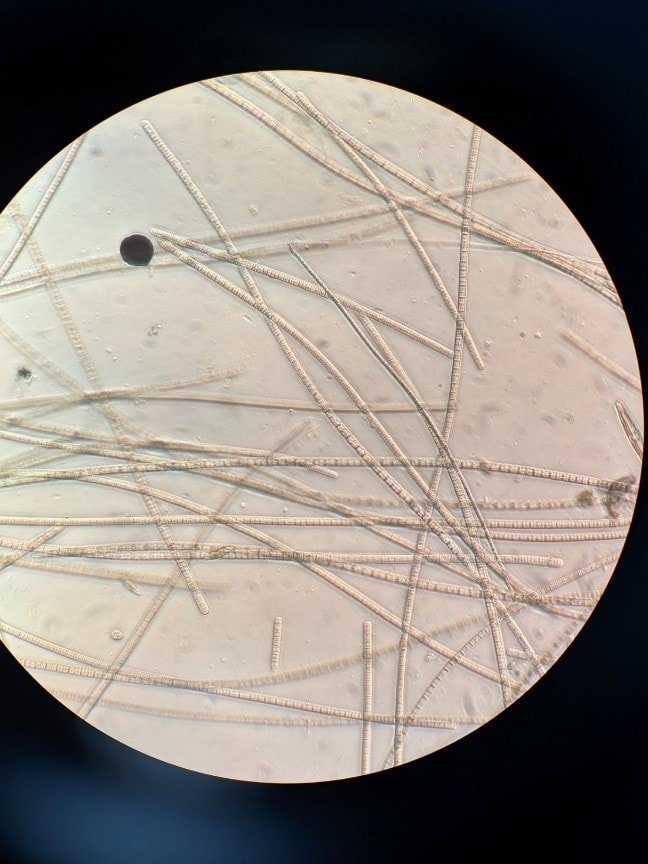Michigan’s Success
Multi-agency Collaboration in Michigan Identifies Cyanobacteria as Likely Cause of Dog Deaths

Oscillatoria sp. of cyanobacteria identified from the Michigan pond associated with dog deaths.
Photo credit: Kevin Goodwin, Michigan Department of Environment, Great Lakes, and Energy
Michigan Citizen Reports Dog Illnesses and Deaths
In July 2019, the Michigan Department of Environment, Great Lakes, and Energy (EGLE) received a citizen report that five dogs had become ill. Three of the dogs showed signs consistent with poisoning, including vomiting, neurologic signs, and rapid deterioration. Four of the dogs died, including two that had sudden, unobserved deaths. All affected dogs swam in or drank water from the citizen’s private pond, located in Michigan’s northern Lower Peninsula, shortly before becoming ill.
State Health and Environmental Agencies Identify Bottom-Dwelling Cyanobacteria in Water Samples
The Michigan Department of Health and Human Services (MDHHS) joined a multi-agency response to investigate the cause of the dog illnesses and deaths. Based on the dogs’ symptoms and exposure, investigators suspected cyanotoxins (poisons made by some cyanobacteria) as a potential cause. However, neither the citizen nor local health department investigators observed a cyanobacterial bloom, and pond water samples initially tested at MDHHS Bureau of Laboratories were negative for three common cyanotoxins—microcystins, anatoxin-a, and cylindrospermopsin.
The cause of the dogs’ deaths remained a mystery. No onsite chemicals or pesticides were reported, and an MDHHS investigation did not find any nearby industry or environmental contaminants. However, investigators noted that Chara—a type of green algae that does not produce toxins—was growing on the bottom of the pond, and the owner frequently removed it.
Next, MDHHS and EGLE investigated whether cyanobacteria might be growing among the Chara. EGLE collected water in two locations in mid-August. In the first location, the Chara was shaken to disturb any cyanobacteria that might be present. In the second location, the Chara was not shaken. Water samples from the location where the Chara was shaken tested positive for anatoxin-a, while samples from the location where the Chara was not shaken were negative for anatoxin-a, microcystin, and cylindrospermopsin. Oscillatoria, a bottom-dwelling (benthic) cyanobacteria that can produce anatoxin-a, was also found in the positive samples. Anatoxin-a is a neurotoxin, and the dogs’ symptoms were consistent with anatoxin-a exposure.
In addition to MDHHS and EGLE, the Michigan Department of Agriculture and Rural Development, Michigan State University’s Veterinary Diagnostic Laboratory, and the local health department had key roles in the investigation, showcasing Michigan’s One Health approach to harmful algal blooms.
One Health Collaboration Increases Awareness of Benthic Harmful Algal Blooms
The dog illnesses and deaths were the first documented cases of animal poisoning caused by benthic cyanobacteria in Michigan. The investigation into these cases raised awareness that benthic cyanobacteria are present in Michigan waters and can produce cyanotoxins at levels high enough to cause animal deaths. As a result, MDHHS has increased its efforts to communicate about potential human and animal health risks for benthic cyanobacterial exposures.
Visit www.michigan.gov/habsexternal icon for more information on harmful algal blooms in Michigan.
For more information about animal illnesses caused by cyanobacteria and how to protect pets and livestock, visit CDC’s Cyanobacterial Blooms: Information for Animal Owners and Cyanobacterial Blooms: Information for Veterinarians.